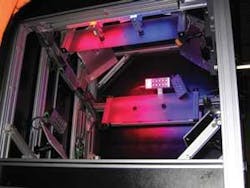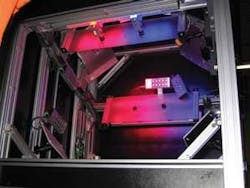Integrators, camera makers, and end users must work together
A discussion with Ross Rawlings of Radix Controls
VSD: How is Radix Controls using machine vision and automated systems?
Rawlings: Radix Controls has been in business for more than 10 years and started primarily as a software-development house specializing in plant-floor data collection and device connectivity. When we began deploying vision systems eight years ago, we extended our software scope to include what would be considered today easy presence/absence of features or simple measurements to pass or fail parts in the foundry and automotive sector.
Soon after we started with vision some challenging opportunities arose. Using a Cognex (Natick, MA, USA; www.cognex.com) Checkpoint PC-based system, we developed a robotic-guidance application that allowed for unattended removal of engine block castings out of dunnage using an ABB (Auburn Hills, MI, USA; www.abb.com) S3 robot for a major automotive company. This initiated what is now an area of expertise for Radix Controls-3-D robotic guidance. Today, we solve many kinds of problems for customers using smart sensors such as the Cognex In-Sight family of vision sensors, as well as more complex technologies such as Vision Pro, a PC-based programming environment for more challenging applications.
VSD: How do you approach a new application?
Rawlings: The most challenging part of machine vision is often the initial interaction with a customer and trying to ascertain the complete scope of work. This will often entail trial runs with sample parts under various lighting conditions. Every effort is made to replicate the customer’s site from a lighting and cycle-time perspective. We have often said to customers, “Vision is 95% lighting.” After creating and demonstrating to the customer a prototype system, we go forward and create a cost-effective proposal that also indicates any cautionary issues that may reduce the effectiveness of this system once deployed on the customer’s floor.
We provide complete turnkey solutions that may encompass PLCs, robotics, fastening and/or marking systems, as well as PC-based client and/or server-side application development to complete a vision-system project. If we do work with an OEM, it tends to be the manufacturer of the customer’s existing equipment, such as Atlas Copco (Auburn Hills, MI, USA; www.atlascopco.com), Motoman (West Carrollton, OH, USA; www.motoman.com), ABB, or Telesis Technologies (Circleville, OH, USA; www.telesis.com).
VSD: What technologies and components does Radix use in these applications?
Rawlings: The primary vision systems we use at Radix Controls today are either the Cognex In-Sight sensor or PC-based Vision Pro product that uses a frame grabber along with a COMM-based vision library. We have been finding that some customers require a collection of cameras within an automation cell that may make the use of smart sensors cost-prohibitive. With a frame grabber and many “dumb” cameras we are able to create automation cells with 20 to 30 cameras.
When creating these types of systems, the frame grabber is often the Cognex 8501 along with either the Sony XC-HR70 or the JAI Pulnix (San Jose, CA, USA; www.jaipulnix.com) CV-A1 camera. We have also recently created a vision product that uses a FireWire camera from PixeLink (Ottawa, ON, Canada; www.pixelink.com) and our own vision software that we have developed for tracking the exact location of handheld tools in 3-D space. This will allow for verification of human-driven tasks by tracking the location of a tool and waiting for tool-driven events to capture the point in space that an event has occurred and recording both the process data for the task along with the position in space that the task has occurred in.
In almost all cases when building an automation system we have a PC present. The PC may be involved in device connectivity, data collection, or direct robot control. In any event, we use our software-development experience and leverage the PC to the maximum. Ethernet connectivity to devices or to a backend data server is also very common and preferred. This way there is no proprietary OEM interface to contend with. We are free to create an open factory environment for process data to travel across.
VSD:What are users demanding from you in the design of new systems?
Rawlings: One of the best things about being a machine-vision integrator is the various kinds of manufacturing facilities we get to see. With this wide variety of manufacturing processes, we find that a common objective for customers is to reduce scrap and therefore create a better part or to reduce downtime and increase throughput. We have seen a rapid increase in the need to track parts throughout the manufacturing process by initially marking a part with a Data Matrix code and tracking that part along with the process data related to the part from creation to completion. The automotive market appears to be leading the way with this part-tracking requirement, but we have also seen this with the pharmaceutical and food-processing facilities.
The other main feature required by our customers in the need to collect and report data that has been collected by vision system analysis of process monitoring and by storing these data in a way that will permit very easy end-user analysis. We utilize Web-based technologies and often create Web reports of plant-floor data that can be viewed from anywhere in a facility by simply using a Web browser. The demand on vision systems to perform more complex operations has also required our systems to have much more smarts behind them to make them easy to use. Most customers never end up being advanced vision system specialists and therefore with more complex systems being deployed it requires us to provided specialized training direct to the customer.
VSD: How is each OEM component more or less important for the applications that you serve?
Rawlings: The most important feature in a vision system that we look for is the feature set of the programming environment. For both the smart sensor and the PC-based solutions we have focused in on the Cognex family of products, mainly because of the long history and strong code base that is present across all the Cognex products. They have created a very good set of vision tools that permits us to extend our abilities to solve problems without a steep learning curve. OEM collaboration is also a key to the success of a project. In the 1980s, vision systems were looked at as the next best thing but were not deployed correctly, and many failed. It is only with open interactive communication with the OEM can we create a win-win-win situation where everybody from the OEM to end user will benefit.
VSD: What could vision-equipment vendors do to make your jobs easier?
Rawlings: Vision-system providers tend to be concerned with the soft components of what they create. The factory floor is not a very pleasant place, and the design of the physical enclosures used tends to take second or third place. That may not be a bad thing, though. We can always build better enclosures but re-engineering a particular software tool may take many man-months of engineering. I would hope for an increase in active feedback to the OEM relating to usability issues that will address the environmental conditions that we see in various facilities.
VSD: What new applications do you expect to emerge?
Rawlings: We have created the first of many specialized vision products using a FireWire camera. I feel that the use of frame grabbers is on the way out. With the increase in processing power of the smart sensor, there may not be a need for the oversized frame grabber that also performs the vision analysis on board. Without the use of the frame grabber and associated PC and industrial enclosure, the smart cameras make economic sense. There are, however, cases that require more power or functionality than the smart camera can provide, and in these circumstances a small industrial PC with FireWire or USB may do the job. I feel that we can take advantage of the powerful programming environments such as VB.Net and C# to allow integrators to piece together technology and create specialized vision sensors that not only perform a particular type of vision inspection but can directly control an industrial robot.
VSD: How will OEM components have to change to meet future needs?
Rawlings: The creators of machine-vision components must stay in touch by interacting with integrators and end users. New components need to encapsulate an open communication interface to permit easy exchange of either image or data into and out of the vision system. Again, we often are blocked by a proprietary protocol in one particular device within an automation cell forcing us to create a software component to bridge the communication gap.
This leads to another issue. We often have to place source code within a smart sensor that may have taken many man-months to engineer only to find it got hijacked and is utilized by a competitor. OEMs should facilitate a mechanism that permits smart components to be compiled and inserted into smart sensors in way that would permit the creator to license the component and not jeopardize the loss of intellectual property. This way the vision-system OEM, the integrator, and end user will all see a quicker and less expensive product that would be far richer in its functionality.
ROSS RAWLINGS is president and CEO of Radix Controls (Oldcastle, ON, Canada; www.radixcontrols.com). He has both a B.S. and a B.A. and a background in industrial automation and personal computing. Editor in chief Conard Holton talked to him about the integration of vision and automated systems.


